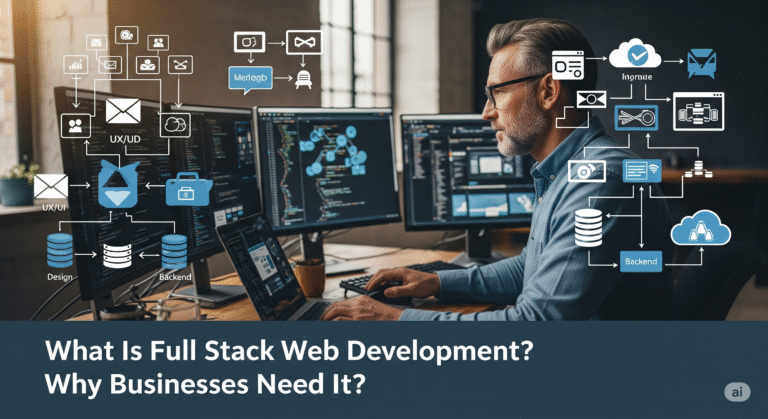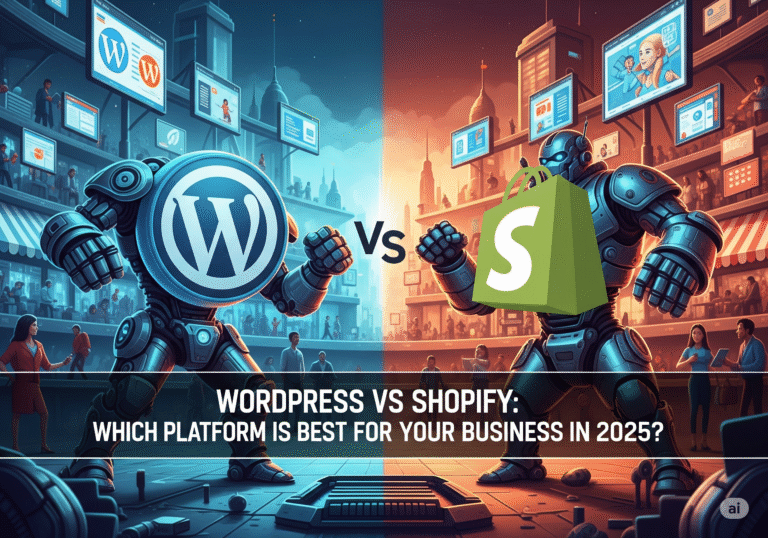5 Emerging Tech Trends 2025: Revolutionary Technologies Shaping Our Digital Future
5 Emerging Tech Trends 2025. The digital landscape is evolving at breakneck speed, and 2025 promises to be a watershed year for technological innovation. As we stand on the cusp of unprecedented technological advancement, businesses and developers must stay informed about the emerging tech trends 2025 that will define the next era of digital transformation.
Understanding these revolutionary emerging tech trends 2025 isn’t just about staying current—it’s about positioning your business for success in an increasingly competitive digital marketplace. From artificial intelligence breakthroughs to quantum computing applications, these emerging tech trends 2025 will fundamentally reshape how we build, deploy, and interact with technology.
Table of Contents
Why Emerging Tech Trends Matter for Your Business
In today’s rapidly evolving digital ecosystem, staying ahead of technological curves isn’t optional—it’s essential for survival. The trending technologies 2025 will bring are not just incremental improvements; they represent fundamental shifts in how we process information, interact with digital systems, and solve complex problems.
According to Gartner’s latest technology predictions, organizations that proactively adopt emerging technologies will gain significant competitive advantages, including improved operational efficiency, enhanced customer experiences, and new revenue streams.
For web development companies like YAAM Web Solutions, understanding these emerging tech trends 2025 means being able to offer cutting-edge solutions that meet evolving client needs. The businesses that thrive in 2025 will be those that can seamlessly integrate these emerging tech trends 2025 into their digital strategies.
The economic impact of these emerging tech trends 2025 is staggering. McKinsey estimates that the global digital economy will reach $23 trillion by 2025, driven largely by these emerging technological innovations. This massive growth creates unprecedented opportunities for businesses willing to adapt and innovate with emerging tech trends 2025.
1. Quantum Computing Integration
The Quantum Leap in Computing Power
Quantum computing represents one of the most significant emerging tech trends 2025 will witness. Unlike traditional computers that process information in binary bits, quantum computers use quantum bits (qubits) that can exist in multiple states simultaneously, enabling exponentially faster processing for specific types of problems.
Key Applications for Web Development:
Cryptography and Security: Quantum computing will revolutionize cybersecurity, both as a threat to current encryption methods and as a solution for quantum-safe cryptography. Web developers must begin preparing for post-quantum cryptographic standards.
Database Optimization: Quantum algorithms can solve complex optimization problems that plague large-scale databases, potentially reducing query times from hours to seconds.
Machine Learning Enhancement: Quantum machine learning algorithms can process vast datasets more efficiently, enabling real-time personalization and predictive analytics on unprecedented scales.
Real-World Impact: Companies like IBM and Google are already offering quantum cloud services, making this technology accessible to businesses of all sizes. IBM’s Quantum Network includes over 200 organizations exploring quantum applications.
Business Implications
The integration of quantum computing into web development workflows will require new skill sets and infrastructure considerations. Early adopters of these emerging tech trends 2025 will gain significant advantages in data processing, security, and algorithm efficiency.
2. Edge AI and Distributed Intelligence
Bringing Intelligence Closer to Users
Edge AI represents a paradigm shift from centralized cloud computing to distributed intelligence processing. This approach processes data locally on devices rather than sending everything to remote servers, reducing latency and improving privacy.
Core Benefits of Edge AI:
Ultra-Low Latency: Processing data at the edge eliminates the round-trip time to cloud servers, enabling real-time responses crucial for applications like autonomous vehicles and augmented reality.
Enhanced Privacy: Keeping sensitive data local reduces privacy risks and helps comply with regulations like GDPR and CCPA.
Reduced Bandwidth Costs: Local processing significantly reduces the amount of data transmitted to cloud services, lowering operational costs.
Improved Reliability: Edge systems can continue functioning even when internet connectivity is limited or unavailable.
Trending Technologies 2025: Edge AI Applications
Smart Web Applications: Websites that can perform AI-powered tasks like image recognition, natural language processing, and predictive analytics directly in the browser.
IoT Integration: Smart devices that can make intelligent decisions without constant cloud connectivity, creating more responsive and efficient systems.
Personalized User Experiences: Real-time content customization based on user behavior analysis performed locally on devices.
According to Forrester Research, edge AI will be deployed in 50% of enterprise applications by 2025, making it a critical consideration for web development projects.
3. Extended Reality (XR) Ecosystems
Immersive Digital Experiences
Extended Reality, encompassing Virtual Reality (VR), Augmented Reality (AR), and Mixed Reality (MR), is evolving from experimental technology to mainstream business tools. These immersive technologies will fundamentally change how users interact with digital content.
XR Applications in Web Development:
Virtual Showrooms: E-commerce websites incorporating 3D product visualization and virtual try-on experiences that increase conversion rates by up to 40%.
Interactive Training Platforms: Web-based training systems that use VR to create realistic, safe learning environments for complex procedures.
Collaborative Workspaces: Virtual meeting spaces that enable remote teams to collaborate as if they were in the same physical location.
Enhanced Accessibility: XR technologies can create more inclusive digital experiences for users with disabilities, offering alternative interaction methods.
Emerging Tech Trends 2025: XR Development Tools
WebXR Standards: The WebXR Device API enables immersive experiences directly in web browsers without requiring specialized applications.
Progressive Web Apps (PWAs): Advanced PWAs that incorporate XR capabilities while maintaining fast loading times and offline functionality.
Cross-Platform Development: Tools that allow developers to create XR experiences that work across multiple devices and platforms.
The XR market is projected to reach $209 billion by 2025, according to IDC’s Worldwide Augmented and Virtual Reality Spending Guide, indicating massive growth potential for businesses investing in these technologies.
4. Sustainable Computing and Green Technology
Environmental Responsibility in Tech
As climate change concerns intensify, sustainable computing has become one of the most important trending technologies 2025 will emphasize. This trend focuses on reducing the environmental impact of technology through energy-efficient hardware, optimized software, and responsible development practices.
Green Web Development Practices:
Energy-Efficient Code: Writing optimized code that reduces server processing requirements and energy consumption.
Sustainable Hosting: Choosing data centers powered by renewable energy sources and implementing carbon offset programs.
Lightweight Applications: Developing applications that require minimal resources while maintaining functionality and user experience.
Circular Design Principles: Creating digital products designed for longevity, reusability, and minimal waste.
Implementation Strategies
Performance Optimization: Techniques like code splitting, lazy loading, and efficient caching reduce energy consumption by minimizing unnecessary processing.
Carbon Footprint Measurement: Tools and methodologies for measuring and reducing the environmental impact of web applications.
Sustainable UX Design: Design patterns that encourage efficient user behavior and reduce unnecessary resource consumption.
At YAAM Web Solutions, we’re committed to implementing sustainable development practices that help our clients reduce their digital carbon footprint while maintaining high-performance applications. These emerging tech trends 2025 represent a shift toward more responsible technology development.
5. Autonomous Systems and Smart Automation
The Rise of Intelligent Automation
Autonomous systems represent the convergence of artificial intelligence, machine learning, and robotics to create self-managing technologies. These systems can operate independently, make decisions, and adapt to changing conditions without human intervention.
Applications in Web Development:
Automated Testing and Deployment: AI-powered systems that can automatically test, debug, and deploy code changes while learning from previous iterations.
Intelligent Content Management: Systems that can automatically generate, optimize, and update content based on user behavior and performance metrics.
Predictive Maintenance: Applications that can predict and prevent system failures before they occur, ensuring maximum uptime.
Adaptive User Interfaces: Websites that automatically adjust their layout, content, and functionality based on user preferences and behavior patterns.
Business Process Automation
Customer Service Automation: Advanced chatbots and virtual assistants that can handle complex customer inquiries and transactions.
Supply Chain Optimization: Automated systems that can predict demand, optimize inventory, and manage logistics without human intervention.
Financial Process Automation: Intelligent systems that can handle invoicing, payment processing, and financial reporting while ensuring compliance and accuracy.
Research from MIT Technology Review indicates that businesses implementing autonomous systems see productivity improvements of 25-50% within the first year of deployment.
How These Trends Impact Web Development
Transforming Development Workflows
The emerging tech trends 2025 will bring fundamental changes to how web developers approach their craft. These technologies don’t just offer new features—they require entirely new ways of thinking about user experience, system architecture, and business strategy.
Development Methodology Changes:
AI-Assisted Coding: Tools that can generate code, suggest optimizations, and automatically fix bugs will become standard parts of the development workflow.
Continuous Integration/Continuous Deployment (CI/CD): Automated systems that can handle the entire development lifecycle from code commit to production deployment.
User-Centric Design: Emphasis on creating experiences that adapt to individual users rather than one-size-fits-all approaches.
Technical Infrastructure Evolution
Cloud-Native Architecture: Applications designed specifically for cloud environments with built-in scalability, resilience, and automation.
Microservices and APIs: Modular application architecture that enables rapid feature deployment and system integration.
Real-Time Data Processing: Systems capable of processing and responding to data streams in real-time, enabling more responsive user experiences.
The shift toward these emerging tech trends 2025 requires developers to continuously update their skills and adapt to new tools and methodologies. Companies that invest in developer training and technology adoption will have significant advantages in the competitive marketplace.
Preparing Your Business for 2025
Strategic Planning for Technological Adoption
Successfully navigating the trending technologies 2025 landscape requires strategic planning and phased implementation. Businesses must balance innovation with stability, ensuring that new technologies enhance rather than disrupt existing operations.
Assessment and Planning:
Technology Audit: Evaluate current systems and identify areas where emerging technologies can provide the most value.
Skill Gap Analysis: Determine what new skills your team needs to successfully implement these technologies.
Resource Planning: Allocate budget and resources for technology adoption, training, and infrastructure upgrades.
Risk Assessment: Identify potential challenges and develop mitigation strategies for technology implementation.
Building Future-Ready Teams
Continuous Learning Programs: Establish ongoing training initiatives to keep your team current with emerging technologies.
Cross-Functional Collaboration: Encourage collaboration between technical and business teams to ensure technology adoption aligns with business objectives.
External Partnerships: Work with technology vendors, consultants, and service providers to access specialized expertise.
Innovation Culture: Foster a culture that embraces experimentation and learning from both successes and failures.
Organizations that proactively prepare for these emerging tech trends 2025 will be better positioned to capitalize on the opportunities these technologies present.
Implementation Strategies
Phased Adoption Approach
Rather than attempting to implement all emerging technologies simultaneously, successful organizations adopt a phased approach that allows for learning and adaptation.
Phase 1: Foundation Building
- Upgrade existing infrastructure to support new technologies
- Implement basic automation and optimization tools
- Train team members on fundamental concepts
Phase 2: Pilot Programs
- Select specific use cases for technology testing
- Implement small-scale pilots with measurable outcomes
- Gather feedback and refine approaches
Phase 3: Scaling and Integration
- Expand successful pilots to broader applications
- Integrate new technologies with existing systems
- Develop comprehensive governance and management processes
Measuring Success
Key Performance Indicators (KPIs):
- User engagement and satisfaction metrics
- System performance and reliability measures
- Cost savings and efficiency improvements
- Revenue growth and market share gains
Continuous Monitoring: Establish systems for ongoing performance monitoring and optimization to ensure technologies continue delivering value.
Feedback Loops: Create mechanisms for gathering user feedback and using it to guide future development efforts.
Conclusion
The emerging tech trends 2025 presents both unprecedented opportunities and significant challenges for businesses and developers. From quantum computing’s revolutionary processing power to sustainable computing’s environmental responsibility, these technologies will fundamentally reshape the digital landscape.
Success in this evolving environment requires more than just adopting new technologies—it demands a strategic approach that balances innovation with practical implementation. The emerging tech trends 2025 will favor organizations that can thoughtfully integrate these advancements into their existing operations while maintaining focus on user value and business objectives.
At YAAM Web Solutions, we’re committed to helping our clients navigate this technological transformation. Our expertise in cutting-edge web development ensures that your business stays ahead of the curve while delivering exceptional user experiences.
The future belongs to organizations that can successfully harness these emerging tech trends 2025 while maintaining their commitment to quality, sustainability, and user-centric design. By starting your preparation now, you’ll be well-positioned to capitalize on the opportunities that 2025 and beyond will bring.
Whether you’re looking to implement AI-powered features, explore quantum computing applications, or develop sustainable web solutions, the key is to start with a clear strategy and committed execution. The technological revolution is here—are you ready to lead it?
Ready to future-proof your business with cutting-edge web development solutions? Contact YAAM Web Solutions today to discover how we can help you implement these emerging technologies and stay ahead of the competition.







